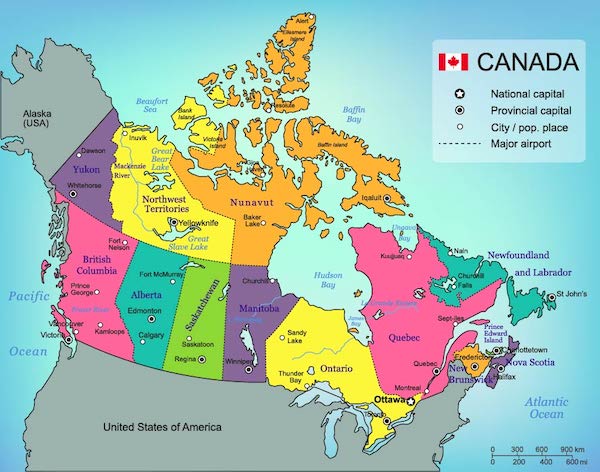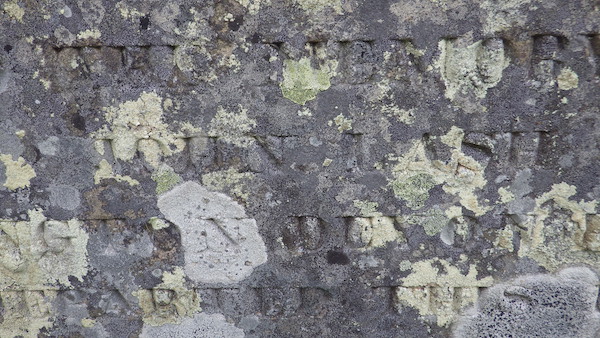On March 18, 2020, the Minister of Health and Community Services in Newfoundland and Labrador, Canada declared COVID-19 a public health emergency and introduced a number of measures, including a stay-at-home order. Now, at the end of June, the “declaration of a public health emergency” is still in effect, but things are slowly opening up with restrictions. Their efforts have been working. They’ve had a total of 261 cases in an estimated population of 520,437, and at the time this post was written (June 26, 2020) they have no known new or active cases of COVID-19.
If you don’t know anything about Newfoundland and Labrador, it is a province of Canada, situated on its east coast. Labrador is on the mainland and Newfoundland is a huge island in the Atlantic Ocean. They are connected by a ferry service.
A bit of trivia: Cape Spear, Newfoundland, is where the sun rises first on the continent of North America.
Here’s a map to help you get your bearings. (Cape Spear is just south of the capital and largest city, St. John’s.)

Why the geography lesson? Because I wanted to give you a little background information to help illustrate how close Newfoundland is to Maine. And to set up a story about why in the middle of this pandemic, I might receive an email from a woman named Suzanne Sexty, who lives in St. John’s, Newfoundland.
This is an excerpt from the email I received from Suzanne:
While social distancing, I am trying to do some research. In particular, I am looking into the background of a Maine nurse (Anna M Davis) who married a Newfoundlander (Kenmure M Blair) at Houlton on March 23, 1921. I am especially interested in where she received her training and if she served as a nurse overseas during World War I.
I look forward to hearing from you.
Suzanne Sexty
Suzanne
Honorary Research Librarian
Memorial University of Newfoundland Libraries
St. John’s, Newfoundland
I didn’t hold out much hope of providing any useful clues but tried. I also asked Suzanne if she’d like to write an essay for Catching Health about how she has been coping with the pandemic and the lockdown in her country. This is her story:
You may be wondering how, and why, a retired librarian in St. John’s, Newfoundland, Canada came to be included in a blog that originates in Maine. Good question. Hopefully, what follows is a good answer.
As soon as we were locked down, other people started cleaning house, cooking up a storm, and buying cartons of toilet paper. I decided that the house would get dirty again, we eat well enough already, and honestly I never did understand the run on toilet paper. On the other hand, I find comfort in doing research, and never has something comforting been needed more.
Suzanne Sexty

The full inscription reads:
[Sacred] to the Memor[y of]
John Lash
[Of Pai]ngton, Devon, E[ngland,]
[Who departed this life on
The 3rd day of June 1847
Aged 35 Years.
And of his daughter
Fanny Ann Fannon
Who died in infancy.]
For the past number of years, my research has involved writing about people buried in a cemetery on our street. I hope that this doesn’t sound macabre, especially in times when we are in a global pandemic and are besieged by reports of dying. It wasn’t a philosophically motivated decision to write about these people, rather a thank-you gesture to my adopted/adoptive home. I wanted readers to consider where we have come from, to appreciate the lives of those who came before us, and maybe to learn to take all that we have less for granted.
When the provincial and federal governments issued stay-at-home requests, I was working on a story about a Newfoundland woman who served with the British army as a nurse in the First World War. During my journey of exploring the life of Annie Frew, what a lyrical name, I encountered her sister-in-law Frances (Blair) Frew who was also a nurse. By then I was deeply into the back story of the role of nurses during the war and thought it would be interesting to look at Frances who served with the Canadian Army Medical Corp (CAMC) and was with the First Canadian Contingency to go overseas.
Doing research is like eating potato chips, you cannot get just one bit(e) of information, you must keep putting your hand back in the chip bag for more. With Frances, my potato chip was figuring out where she received her nurse’s training. I looked, and looked, and looked, but could not find the answer. A search for information on her siblings revealed that Frances’ brother Kenmure Blair (37, merchant, residing in St John’s, NL) married Anna M. Davis (28, nurse, father Daniel) at Houlton, ME on January 19, 1922. How did Kenmure meet Anna? The connection between Newfoundland and Maine was not obvious, maybe it was Frances. Did Frances and Anna train together? Did they meet during the war?
Enter Diane and her awesome Catching Health website. You won’t be surprised to learn that Diane responded immediately to my request for information about where nurses at the turn of the last century received their training. Unfortunately, none of Diane’s suggestions for further research have led me to a connection between Anna Davis and Frances Frew or her brother, but they have certainly provided food (another potato chip?) for thought. Sometimes a researcher must accept that the resolution of a search is that there is no resolution, at least not now, not yet. Altogether not a bad lesson.
The article on Frances will be published in the Ancestor, a quarterly journal of the Family History Society of Newfoundland and Labrador. The purpose of the article is to encourage people to look beyond the “begats” of their ancestors – the births, marriages, and deaths – and to put their lives into context. While it tells about a period in Frances’ life, the years leading up to her going to war, it was also written to demonstrate how much research can be done during a lockdown. Libraries, archives, people like Diane are still accessible, and valued gatherers of information waiting to be retrieved.
One last word on Frances and another of the lessons one learns, even when not looking for them. Frances was widowed shortly after her 1904 wedding to William Frew. A few years later she moved to Canada (Newfoundland was not part of Canada until 1949). At some point, she received her nurse’s training and, in September 1914, enlisted in the Canadian army. During the war, Frances served on The Front in France where she met John Hunt, a doctor in CAMC. They married on October 14, 1915. Their son, John Blair Hunt, was conceived in France, born in Canada, and died in Italy in 1943 while serving as a captain in Princess Patricia’s Canadian Light Infantry during the Second World War. Frances’ life was so much more than her 80-word obituary or her entry in a family tree – everyone has a story.
Suzanne Sexty
I’d also like to give a shout out to Juliana L’Heureux, who writes the BDN blog Franco-American News and Culture. She also co-authored the book Maine Nursing: Interviews and History on Caring and Competence, which traces the history of nursing in Maine from 1914 to 2014. I reached out to Juliana and she passed along some suggestions to Suzanne, but unfortunately, they didn’t lead where we all hoped they would. Who knows, maybe someone will read this post and offer some “potato chips.”
If Suzanne’s story inspires you to do some research or to look into your own family’s history, she encourages you to do so and to go beyond just creating a family tree or gathering vital statistics.Dig and you might discover some interesting stories.
She also told me that “during the pandemic, the provincial museum/archives has been gathering stories from people relating to what life has been like for them at this time. The point is that so much of the research which we do today is from public sources – newspapers, deeds, wills, vital statistics – and so little from people recording in their own words the time in which they are living. This is especially true of people who are not public figures which is why I write about them. The collection of present-day stories is a reminder that we are creating what will tomorrow be history. The cautionary message is if you want your story to exist in the future, be sure it is put somewhere that people will be able to find it.”
If you’re looking for a project to do while you’re on lockdown and you’re not interested in researching anything, perhaps you could start recording or writing down your own story, or what about interviewing an older person in your family? Everybody has a story to tell if only someone would ask.
If you’d like to read more stories about how people have been coping with the pandemic, you’ll find several here at Catching Health and if you’d like to listen to some conversations with older people about their lives (or read a transcript), check out my podcast project Conversations About Aging.
No matter where you live, I hope you are doing well. Thank you, Suzanne, for your story and your inspiration.


Leave A Comment